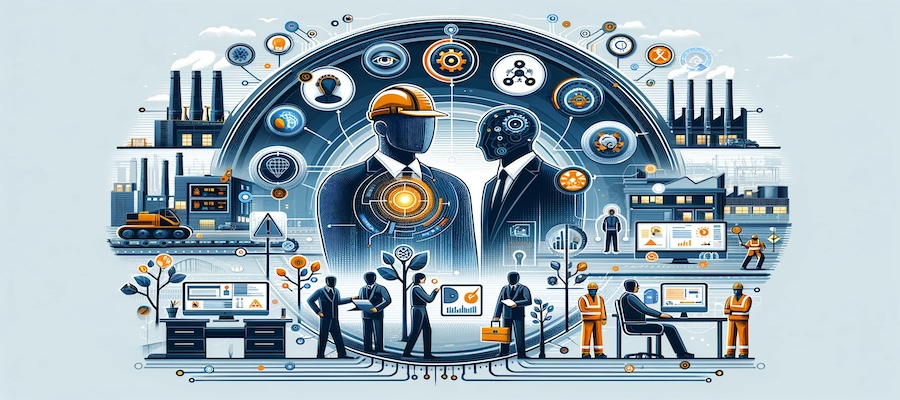AI and EHS Management: Collaborating for Enhanced Workplace Safety

In the realms of construction, manufacturing, and logistics, the roles of Environmental, Health, and Safety (EHS) managers are crucial. These professionals are tasked with the immense responsibility of ensuring safe working conditions, compliance with safety regulations, and reducing workplace hazards. However, the advent of Artificial Intelligence (AI) in the domain of workplace safety presents a groundbreaking shift. AI technologies, such as those offered by Securade.ai, are not only complementing but also enhancing the capabilities of EHS managers.
This blog post delves into how AI is transforming the landscape of workplace safety, the role of EHS managers in this new era, and the dynamic relationship between AI and EHS management. We will explore the synergies and collaborative opportunities that AI offers to improve safety protocols, using Securade.ai as a case example to illustrate this progressive integration.
Roles of an EHS Manager
Environmental, Health, and Safety (EHS) managers play a pivotal role in high-risk industries such as construction, manufacturing, and logistics. Their primary responsibilities revolve around ensuring the safety and health of employees, compliance with environmental and safety regulations, and implementing effective safety policies and procedures.
- Ensuring Compliance: EHS managers are tasked with making sure that workplaces adhere to local, national, and international safety laws and regulations. This includes conducting regular audits, providing training, and updating safety protocols as regulations evolve.
- Risk Assessment and Management: Identifying potential hazards, assessing risks, and implementing proactive measures to mitigate them is a core function of EHS managers. They must continuously monitor workplace environments to anticipate and prevent accidents.
- Emergency Response Planning: Preparing for and managing emergency situations, including accidents and environmental disasters, is a critical responsibility. EHS managers develop and maintain emergency response plans to ensure swift and effective action when needed.
- Employee Training and Awareness: EHS managers are responsible for educating the workforce about safety practices, conducting regular training sessions, and fostering a culture of safety within the organization.
- Incident Investigation and Reporting: In the event of a workplace incident, EHS managers conduct thorough investigations to determine the cause and develop strategies to prevent future occurrences. Accurate reporting and documentation are also key aspects of their role.
The integration of AI technology in these areas offers new possibilities for improving safety measures, predictive analysis, and efficient management of safety protocols.
The Rise of AI in Safety Management
Artificial Intelligence (AI) has begun to play a transformative role in the field of safety management, especially in high-risk industries. This section explores how AI technologies are revolutionizing safety protocols and complementing the efforts of EHS managers.
- Advanced Surveillance and Monitoring: AI-powered video analytics platforms, like Securade.ai, use sophisticated algorithms to monitor workplaces in real-time. They can detect potential hazards, unauthorized personnel in restricted areas, and non-compliance with safety gear requirements.
- Predictive Analysis for Hazard Prevention: AI systems can analyze historical data to predict potential risks and suggest preventive measures. This predictive capability enables proactive management of safety concerns before they escalate into incidents.
- Automated Compliance Checks: AI tools can automate the process of ensuring compliance with safety regulations, reducing the manual workload on EHS managers and enhancing accuracy.
- Real-Time Incident Response: With AI, incident detection and response can be significantly faster. AI systems can immediately alert managers and relevant personnel when a safety breach or hazard is detected.
- Employee Safety Training: AI can also play a role in training employees by providing interactive and personalized safety training experiences, ensuring higher engagement and retention of safety protocols.
The integration of AI into safety management represents a significant advancement in the field, offering new tools and methodologies to EHS managers in their quest to maintain safe and compliant work environments.
AI and EHS Managers: A Collaborative Approach
The integration of Artificial Intelligence (AI) in workplace safety does not replace the role of Environmental, Health, and Safety (EHS) managers but rather augments it. This section explores how AI and EHS managers can work together to create a safer working environment.
AI technologies bring a new dimension to safety management, offering tools that can significantly enhance the effectiveness of EHS managers. For instance, AI can handle routine surveillance tasks, process vast amounts of data for risk analysis, and provide predictive insights that were previously unattainable. This allows EHS managers to focus on more strategic aspects of safety management, such as policy development, employee engagement, and continuous improvement of safety practices.
Moreover, AI-driven solutions, like Securade.ai, serve as a force multiplier for EHS managers. These platforms can monitor compliance in real-time, identify potential hazards instantly, and even aid in emergency response. As a result, EHS managers are better equipped to make informed decisions, respond to incidents more effectively, and implement proactive safety measures.
The collaboration between AI and EHS managers also extends to training and awareness programs. AI can tailor safety training to individual needs, making it more engaging and effective. This personalized approach ensures that employees are better prepared to handle workplace hazards, further supporting the efforts of EHS managers.
In summary, the synergy between AI and EHS managers creates a more robust safety management system. By combining the predictive power of AI with the strategic oversight of EHS professionals, industries can achieve higher standards of safety and compliance, ultimately protecting their most valuable asset - their workforce.

Securade.ai: An Example of AI and EHS Manager Collaboration
Securade.ai stands as a prime example of how Artificial Intelligence (AI) can be integrated with Environmental, Health, and Safety (EHS) management to create a safer workplace. This platform exemplifies the potential of AI and EHS collaboration in high-risk industries like construction, manufacturing, and logistics.
- Real-Time Insights and Monitoring: Securade.ai utilizes advanced AI algorithms for real-time video analytics, enabling immediate detection of safety breaches or potential hazards. This capability significantly enhances the surveillance and monitoring functions traditionally overseen by EHS managers.
- AI Marketplace and Custom AI Models: The platform's AI marketplace offers custom AI models tailored to specific industry needs. This allows EHS managers to adopt solutions that are highly relevant to their unique workplace environments and challenges.
- Policy Compliance and Proactive Safety Measures: Securade.ai aids in ensuring policy compliance by automatically detecting deviations from safety protocols. It also provides valuable data for EHS managers to develop more effective and proactive safety measures.
- Mobile Deployment and Incident Response: With Securade.ai Tower™, the platform offers mobile deployment solutions that are particularly useful for dynamic and changing work environments. This feature aids EHS managers in maintaining safety standards across various locations and in responding promptly to incidents.
- Worker Safety and PPE Detection: The platform's ability to detect whether workers are wearing the proper personal protective equipment (PPE) is a critical aspect of maintaining a safe workplace. This automatic detection supports EHS managers in ensuring that safety gear compliance is consistently met.
Securade.ai demonstrates the powerful impact of combining AI technology with the strategic oversight of EHS professionals. It serves as a model for how AI can enhance traditional safety management practices, leading to more efficient, effective, and safer workplaces.
Embracing the Future of Workplace Safety with AI and EHS Collaboration
As we navigate through the evolving landscape of workplace safety, the collaboration between Artificial Intelligence (AI) and Environmental, Health, and Safety (EHS) managers stands out as a beacon of progress. The journey of integrating AI into EHS management, as exemplified by platforms like Securade.ai, has opened new horizons for enhancing workplace safety in high-risk industries.
AI's ability to provide real-time insights, predictive analysis, and automated compliance checks complements the strategic and human-centric approach of EHS managers. This synergy not only enhances the efficiency and effectiveness of safety protocols but also paves the way for a more proactive approach to managing workplace hazards.
The challenges, such as data normalization, AI system training, and resource allocation, are significant but not insurmountable. By addressing these challenges, organizations can fully harness the potential of AI to transform their safety management practices.
Looking ahead, the integration of AI in EHS management is set to redefine the standards of workplace safety. It promises a future where safety is not just reactive but predictive and preventive, a future where technology and human expertise work hand in hand to create safer work environments for all.